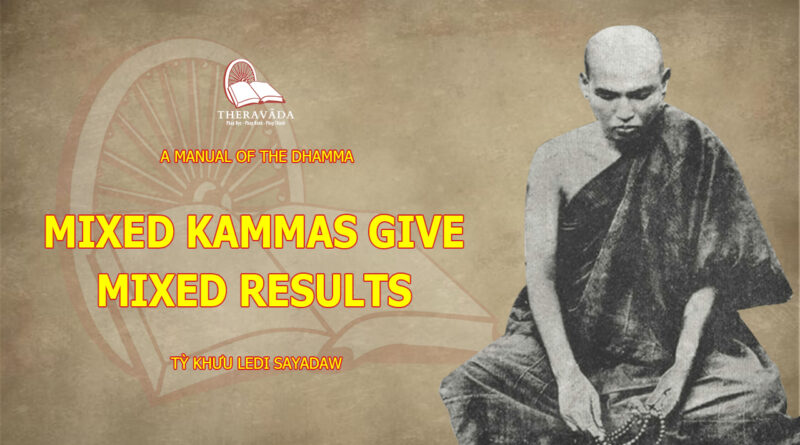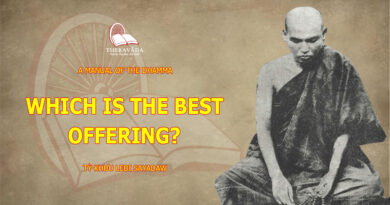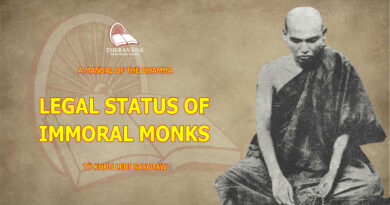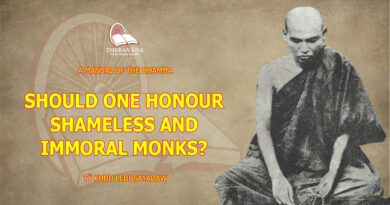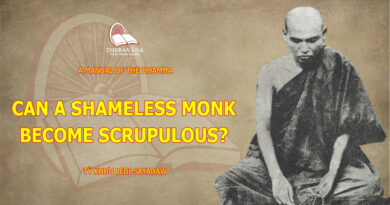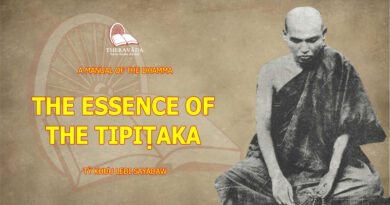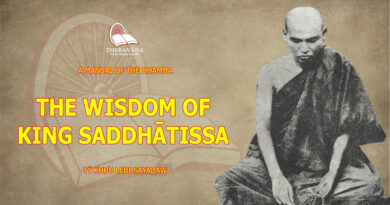Mixed Kammas Give Mixed Results
As mentioned earlier, one who does deeds with mixed motives gets mixed results. Due to his generosity he gains wealth, influence, and power. However, due to the accompanying unwholesome kamma he suffers untimely death. Kings slay him to confiscate his immense wealth, his property is stolen frequently, his house is burnt down, or he suffers from various diseases. Why is this? When he performed good deeds it was associated with some unwholesome kamma. So an unblemished result is not possible for a whole series of lives. This type of kamma is a mixture of black and white. In other words, such moral deeds have been planted with poison at their bases, so to speak. So the four factors of the immoral deed of killing will be present in such a deed. One should note that if only one factor is present, morality is stained, which is the minimum bad effect. Moreover a person destroys the factor of being well-trained in discipline. That is why the crucial words, “Well-trained means purification of defilements, and devoted practise of moral discipline”¹⁵ are used in the Maṅgala Sutta Commentary.
A lay person must observe the five moral precepts to the best of his or her ability. He or she must know the nature and factors of evil and good deeds in each case.¹⁶ Four factors will amount to either unwholesome or evil kamma in the first precept. The remaining nine misdeeds, if transgressed with the four factors,¹⁷ amount at least to unwholesome kamma: stealing, sexual misconduct, lying, slandering, harsh speech, idle-chatter, ill-will, covetousness, and wrong view. So the ten evil deeds become forty in total, with each factor promoting unwholesome or evil kamma.
Those who abstain from each evil deed, in all four aspects, are the practitioners of the Maṅgala Dhamma “well-trained in discipline.” They become truly modest, scrupulous, and good people. The Buddha taught the ten evil deeds with the four factors and their characteristics. One must observe them fully to be free from taints and the four corresponding evil kammas.
The essential factors according to the teaching “devoted practise of moral discipline” are explained in the Siṅgālovāda Sutta, which is commonly called “the lay person’s discipline.” In it one will find a householders’ duties and virtuous conduct explained in detail. Like the Maṅgala Sutta, the Siṅgālovāda Sutta is famous.
Therein, the duties of children, parents, teachers, etc., are taught as disciplines for householders, so it is called the householder’s Vinaya. If children practise their five moral duties to their parents they achieve the status of a good person as well as the Maṅgala Dhammas. Conversely, children who fail in these moral duties destroy the Maṅgala Dhammas and fail to achieve the status of a good person. The exposition in the Commentary is very clear. Therefore everyone needs to fulfil their moral responsibilities, and to follow the path of great and noble virtues based on knowledge and insight. If customary duties concur with the teaching in the Maṅgala and Sīgālovāda Suttas they should be followed with devotion. Among lay people, few perform these universal moral duties in full.
This section explains the meaning of the Maṅgala Dhamma “well-trained in discipline” in relation to a lay person’s Vinaya. Lay people have a natural discipline called “Good conduct” (sucarita vinaya), and “Virtuous conduct” (ācāra vinaya), which they should try to maintain in full with faith and diligence. This ethical conduct was prescribed for the laity by the Buddha, so they do not need to learn the Vinaya for monks.
However, wise lay persons who want to promote the Buddha’s teachings, and are well versed in their own discipline, do need to learn the monks’ Vinaya. Why? Those who are well-trained in the householder’s discipline become truly good people, so their minds and motives are good. If they are well controlled by the lay person’s discipline, after learning the monks’ Vinaya, they will not use their knowledge unwisely. They will not defile themselves with impure physical, vocal, and mental actions. They will not accumulate evil motives and evil kammas because of this new knowledge. In the Commentary it is mentioned that a wise, learned brahmin, after listening to the monks’ Vinaya rules in detail, developed a clear mind and strong faith in the Saṅgha. He appreciated the power and significance of the monks’ Vinaya as clear understanding had revealed its profundity.
One day a devoted brahmin heard the monks reciting their Vinaya rules. Appreciating the benefits of these numerous rules he entered the Saṅgha. Thus one’s own attitude and motive are crucial to evaluate the knowledge of Vinaya rules and the diverse conduct of monks.
The way for a lay person to study the Vinaya is first to learn and practise the lay person’s Vinaya, which gives culture, wisdom, and knowledge. A lay person must be dedicated to observing lay ethics with perfect integrity. If integrity is lacking, a lay person, though learned in ethics, becomes a hypocrite with sham morality. He or she becomes a bad person. This type of lay person, who learns the monks’ Vinaya, will develop a fault-finding attitude. Seeing only the offences and weaknesses of monks, he or she will blame, slander, and abuse them. So there is no benefit for such a lay person in learning the monks’ Vinaya. Since he or she fails to learn and practise the lay person’s Vinaya well, he or she lacks fundamental virtues and a skilful mental attitude. So it is futile to learn the monks’ Vinaya, since he or she will criticise the conduct of wayward monks, interfering in the affairs of others. Such a person who quotes the Vinaya texts and blames the monks, makes evil kamma because he or she lacks the virtues of a good and moral person. Due to these defects he or she takes a superior stance, uttering words of condemnation and slander. Thus, grave evil kammas result from his or her learning.
Seeing only the bad conduct of a wayward monk, he or she blames him, but this gives bad effects. Concentrating on the faults of others, he or she fails to see their virtues. If the monk has not committed one of the offences of defeat, the fundamental morality of a monk remains intact, but it is not seen by his detractor. These remaining precepts are more than nine billion. An educated lay person sees and blames the committed offences only, not the fundamental morality, which still exists. The critic does not see the virtue of this fundamental morality, but sees the defects of the monk only. Thus the evil that he or she gets in the act of condemnation is not due to the defects of the monk concerned, but due to the monk’s status that still prevails. So a critic gets numerous evils in speaking against this Dhamma.
Those with an undeveloped mind and a weak character often see the faults of others. Inevitably they slander, abuse, and use harsh words against those who commit evil deeds. They castigate monks who are of poor moral character. If this type of lay person learns the monastic discipline, he or she foolishly accumulates evil kammas due to lack of restraint. Therefore only disadvantages exist for such a person in studying the Vinaya.
Those who accuse immoral monks with unfounded charges suffer evil just as if they accused a scrupulous monk. Monks get an offence of Saṅghādisesa, which is very grave. The Vinaya text declares, “Asuddha hotipuggalo aññataraṃ pārājikaṃ sammāpanno.” The meaning is that those who accuse monks of immorality are themselves impure. The term “immoral” means, in the final analysis, covetousness or greed, ill-will, and wrong view. Akhanti means impatience or surliness. Añāṇa means ignorance or delusion (moha). Kossajja means laziness or moral slackness. Muṭṭhasati means lack of mindfulness or lack of clear comprehension.

